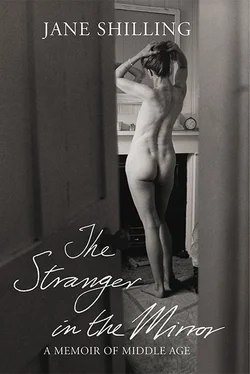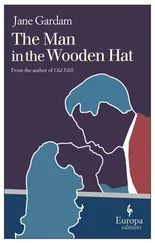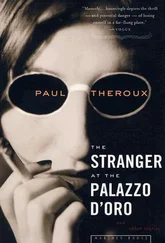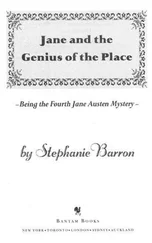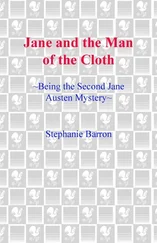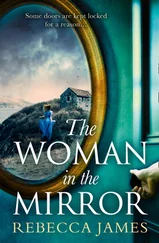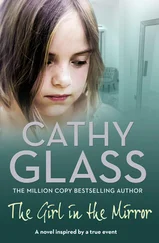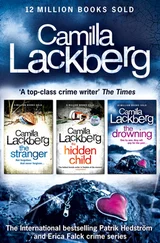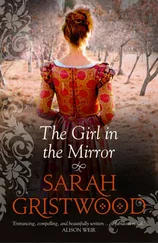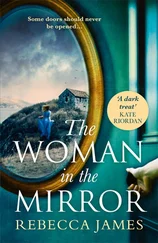At last, at nearly 16, it happened to me, too: the disturbing sprouting and reshaping of the body and the feelings; the messiness of womanhood with its complicated secret paraphernalia – the sordid elastic rigging of training bras and sanitary belts and half-slips, their utilitarian function rather emphasised than disguised with coy embellishments of scratchy nylon lace and little ribbon bows; the half-smug, half-rueful expressions of the handful of girls excused each week from swimming lessons, the sinister pains in one’s joints and abdomen, the greasy, lumpy ruin of one’s childish skin, the giggling and swooning over pop stars, make-up and boys.
At 17, I am still at the graceless, half-fledged stage of the transition from child to woman. The training bra slips about uselessly on my flat chest and is spitefully remarked on by the bosomy girls when we get changed for PE. I am interested in clothes and make-up and being allowed to wear high-heeled shoes (these are forbidden in our house). I am fascinated by the exotic emotional dilemmas of girls my age, who write in to Cathy and Claire, the agony aunts of a teen magazine called Jackie (also on the domestic Index of proscribed items). I can’t see the point of Donny Osmond or David Cassidy, who look to me, with their polite smiles, pastel trouser suits and mid-length bouffants, a bit like some of my friends’ mothers – distinctly low on sexual allure, at any rate.
I harbour a passionate, unreciprocated attachment to a boy from my old primary school, but that’s been going on since we were both five years old, so it’s hard to know whether it belongs among the vague feelings of nameless discontent and unspecified longing that have been troubling me this summer.
At the moment, my erotic imagination is more engaged by girls than boys. The pictures on my bedroom wall, the objects of my narcissistic daydreams, are of the wayward jolies laides I would like to become when my chrysalis of suburban adolescence eventually ruptures to let me out: Janis Joplin in her tattered peacock finery; Patti Smith and her dandyish androgyny. But between dreams of becoming a Rimbaudesque âme damnée with kohl-rimmed eyes, I still quite often play with my doll’s house. And along with those instruction manuals of female adolescence, Wuthering Heights, The Bell Jar and Claudine at School , from time to time I secretly reread a book from my early childhood called The Very Little Girl .
This is a book by an American author, Phyllis Krasilovsky, with delicate, Frenchified illustrations by Ninon in a palette of four colours – black, white, powder pink and a vivid spring green – that seems somehow both innocent and vicious. The story is a simple version of that most basic of fairy-tale archetypes, the transformation narrative.
‘Once there was a little girl,’ it begins, ‘who was very very very little.’ There follows a list of all the things she was smaller than – rose bush, kitchen stool, mother’s work basket, all her friends – and a description of the privileges attached to her diminutive size: ‘A special little chair to sit on and a special little table to eat on and a special little bed to sleep on.’ Very desirable, they are, the pictures of tiny furniture, especially the special little bed – a white four-poster strewn with rosebuds and covered with a frilly pink counterpane.
At the halfway point of the story, the transformation sets in. One day the very little girl finds the proportions of the world have shifted. She is bigger than her dog; she can lift up her cat and see over the garden fence. Insects, lizards and rabbits are smaller than she, as are her special little table, chair and bed. The illustration, a night scene sombrely shaded in dark grey, shows her uneasily crammed into the dwarfish four-poster with her feet sticking out at the end, looking cold and uncomfortable.
On the next page, the night-time crisis is over. There follows a list of the advantages of being a big girl: a new bed – just as frilly as the old one, but roomier – meals eaten at the big table with her parents, games with the other big girls. Best of all, ‘Now she was big enough to be a big sister to her brand new baby brother who was very very very little!’ As a narrative for a young child facing the prospect of a new baby in the family, the message could hardly be more reassuring – Change is exciting! Growing up is good! – were it not for the tendency of the illustrations delicately but devastatingly to subvert the text.
In the early images, the very little girl trots about barefoot and unoccupied, marvelling at the bigness of the world with a toddler’s intent absorption. There follows the noirish crisis of her growing bigger, after which there comes a subtle change, not just in her appearance, but in the quality of her engagement with the world. She no longer runs about barefoot, but is shod in flirtatious pink mules. She wears a frilled apron with a bib and is shown performing a series of housewifely tasks – picking fruit, taking a packet of something out of a cupboard, testing her baby brother’s milk by squirting a few drops from the warmed bottle on to her wrist and finally feeding him the bottle with a maternal air as he reclines like a little emperor on a pink cushion.
Growing bigger has given her a mastery over the world that she lacked when she was small. She can reach the door handle, she can see over the fence: to this extent her transformation has given her power to explore a universe beyond the tiny strangenesses of her domestic boundaries. But her vanished littleness has taken with it a kind of liberty. The world shrinks as the child grows, pressing her into shape as it contracts. In the feathery pink and green pictures of her testing her brother’s bottle and feeding him, there is an edge of melancholy that disturbs me. It is as though the little girl’s fate has hardened as she has grown into the age of responsibility. In the sweetly maternal pictures of her caring for her baby brother, there is an ominous prefiguring of the housewife she is destined to become.
Though I have been mocked at school for being the last person in my class to cross the frontier between childhood and womanhood, privately I cling to what remains of my tenacious littleness. Smallness gives me, like the Very Little Girl, the illusion of floating in a world of infinite possibility. It seems a kind of refuge. Small and overlooked, you can inhabit a world of your own imagining. But once you grow large and bosomy, it strikes me that your opportunities start closing down at a hectic rate.
Already I know I will never be a ballerina, a musician, a gymnast or a vet. Like every teenage girl of my generation, I have been captivated by the performance of Olga Korbut in the 1972 Olympics. Her effortless, sinewy, child-woman charm was so potent as to persuade us all that we, too, could be Olgas. I am physically maladroit. Even so, I manage to convince myself that the force of my imagination will be enough to propel me from the ground in an antic series of leaps and turns and scything airborne twists like hers, until a crushing series of experiments with gravity on our back lawn proves me wrong.
The details of Olga’s brutal training regime are not yet public knowledge. They will emerge a couple of decades later, when she has thickened from the enchanting Olympic waif into a sturdy American housewife with a story to tell. But already I have discerned that the power of wishing, which seems so potent and – sometimes – so effective when you are a child, is ineffectual when it comes to the bleak business of being grown up.
Willpower has failed to make me execute a flip-flop like Olga Korbut. It has failed to take me beyond grade 5 at the piano, or grade C in O-level sciences. It has failed even to allow me to do the splits like my mother could when she was a little girl on a beach in Cornwall. Life, I am beginning to apprehend, is not simply a matter of wishing for things to happen, but some much more chancy combination of opportunity and fate. Which is all very well, if you feel certain of seizing the right opportunity when it presents itself. Unnerving if you don’t.
Читать дальше
